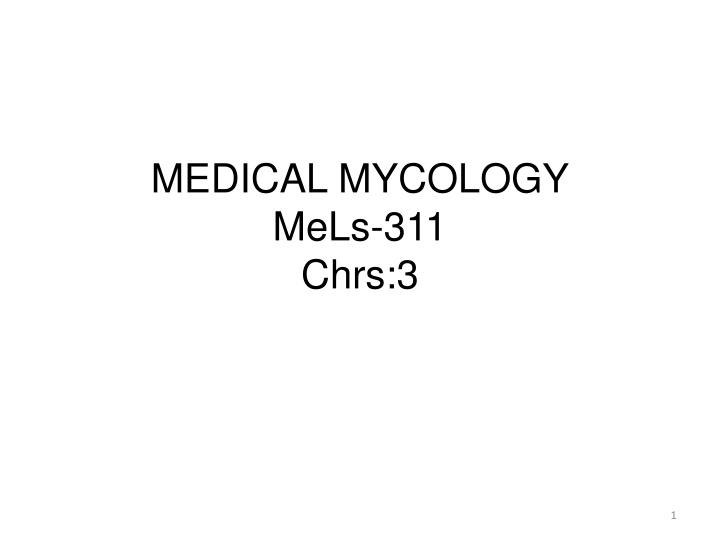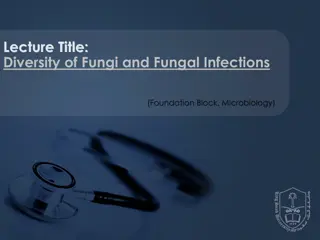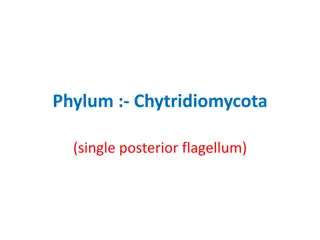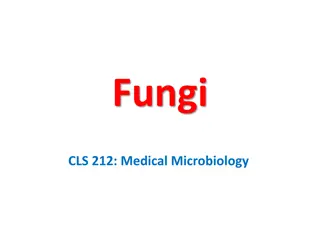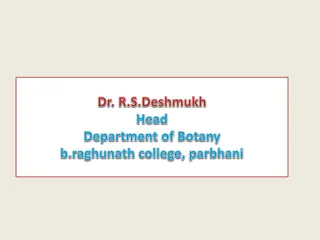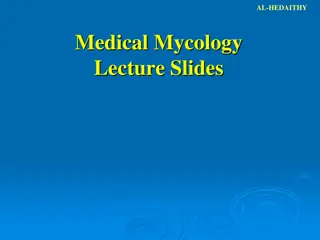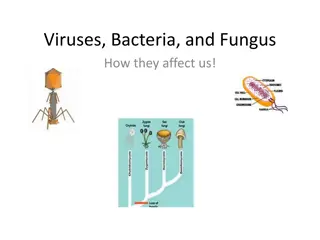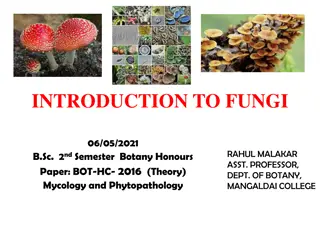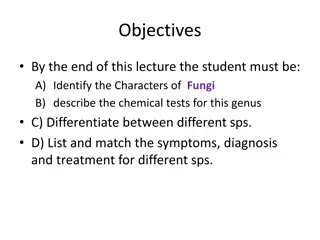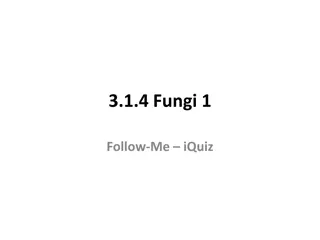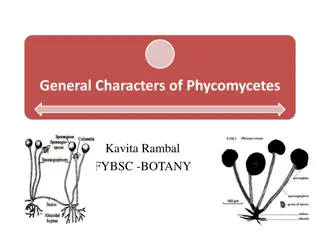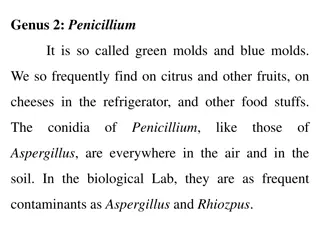An Overview of Medical Mycology: Fungi and Their Characteristics
Medical mycology, focusing on fungi that infect humans, explores the study of fungi, their morphology, classification, and diseases. Fungi, non-photosynthetic organisms, lack chlorophyll and depend on external organic sources for nutrients. With an eukaryotic nature, fungi exhibit less differentiation than plants but more organization than bacteria.
Download Presentation

Please find below an Image/Link to download the presentation.
The content on the website is provided AS IS for your information and personal use only. It may not be sold, licensed, or shared on other websites without obtaining consent from the author.If you encounter any issues during the download, it is possible that the publisher has removed the file from their server.
You are allowed to download the files provided on this website for personal or commercial use, subject to the condition that they are used lawfully. All files are the property of their respective owners.
The content on the website is provided AS IS for your information and personal use only. It may not be sold, licensed, or shared on other websites without obtaining consent from the author.
E N D
Presentation Transcript
MEDICAL MYCOLOGY MeLs-311 Chrs:3 1
Chapter one Introduction to Medical Mycology 2
Acknowledgments Addis Ababa University Jimma University Hawassa University Haramaya University University of Gondar American Society for Clinical Pathology Center of Disease control and Prevention in Ethiopia. 3
Objectives At the end of this chapter, students will be able to: Define fungi List the differentiating characteristics of fungi from bacteria. Explain the morphology of fungi. Describe the classification of fungi. Discuss the disease of fungi. 4
Definitions Mycology The study of Fungi Medical Mycology The study of Fungi that infect humans Fungi are : Plant structures Lack the definite root, stem, and leaves of highly organized plants. 5
Introduction continued All fungi are eukaryotic(with true nucleus). They show less differentiation than plants, but a higher degree of organization than the prokaryotes bacteria 6
Intro Continued Macroscopic and microscopic forms. Macroscopic fungi Often called fleshy fungi Are filamentous organisms Microscopic fungi exist as either Molds that grow on bread, fruits and cheese or Yeasts used in baking industry 7
1.1. General characteristics of fungi Cell walls are composed of chitin Chitin is a ( 1-4)-linked polymer of N-acetyl-D- glucosamine (GlcNAc). Cell membrane contain Ergosterol rather than cholesterol. Fig 1.cell wall and membrane of fungi Adopted from Sherris Medical Microbiology
Characteristics contd Fungi are non-photosynthetic organisms Do not contain chlorophyll Are unable to manufacture their own nutrients, Depend on an external source of organic compounds for growth and survival. Nutrients are usually obtained from dead organisms. But Some fungi use living tissue as a food source e.g. Candida Fungi are non motile 9
1.2. Morphology of the Fungi Medically important fungi are microscopic and exist into two morphological forms: Mold Yeast 10
1.2.1. Mold Filamentous , multi-cellular, forms mostly found outside the body and at room temperature. Hyphae Is the basic microscopic unit of the molds Long tube like structure responsible for the fluffy or cotton ball appearance of the macroscopic mold colony. 11
Mold contd Fig 2. morphology of fungi Adopted from Kyser General Mycology 12
Mold contd Mold are classified and identified partially on the basis of whether the hyphae are septate or aseptate. Septate hyphae Filaments with cross-walls or septa that partition the hyphae in to individual cellular compartments. Have pores that allow the migration of cytoplasm and many organelles. Aseptate hyphae - no physical boundaries to distinguish individual cells in the hyphae. 13
Hyphae contd Fig 3. septate and aseptate hyphae 14
Hyphae contd Hyphae grow as an intertwined mass of filaments collectively called mycelium When mold grow on substrate it can form :- Vegetative mycelium (Thallus) Nutrient absorbing and water exchanging portion of the fungi Grows in or on a substrate. Are actively growing and form the main body of the colony. Arial hyphae (mycelium) Fungal filaments or hyphae that protrude above the surface Produce asexual spore 15
1.2.2. Yeasts are single cells, usually spherical to ellipsoid in shape and occurs singly, in pair or form a chain(bud) Structure mostly found inside tissue or at body temperature Form psedohyphae not a true hyphae 16
Yeast contd Fig 4. yeast and its pseudohphae Adopted from Sherris Medical Microbiology 2004. 17
1.2.3. Dimorphism Some fungi grow only in the yeast form; others grow only as molds. but there are fungus that exist as mold and yeast depending on certain growth conditions; such phenomenon is dimorphism For example, many fungi grow as molds at room temperature (240c) but transforms into yeasts at human body temperature (370c) Most of the more dangerous human pathogenic fungi are dimorphic 18
1.2.4. Fungal Reproduction Sporulation(process of making spores) is the principal means by which fungi reproduce and spread through the environment. Fungal spores are metabolically dormant, protected cells. They can be borne by air or water to new sites, where they germinate and establish colonies. Mold reproduce by Asexual spores and Yeast reproduce with budding and sexual spore 19
Fungal repro contd Spores can be generated either asexually or sexually Many fungi can produce both sexual and asexual spores. Fungi that exhibit sexual phase are known as the perfect fungi Fungi imperfecti or deuteromycetes are the designation for a type of fungi in which the sexual cycle are either unknown or missing entirely. Sexual spores are rarely agents of human disease. 20
Fungi reproduction contd 1. Asexual sporulation: Asexual spores are mitotic progeny (ie, mitospores) and genetically identical. The medical fungi produce two major types of asexual spores, conidia, and, in the zygomycetes, sporangiospores. In some fungi, vegetative cells may transform into conidia (eg, arthroconidia, chlamydospores). In others, conidia are produced by a conidiogenous cell, such as a phialide, which itself may be attached to a specialized hypha called a conidiophore. 21
Asexual Contd In the zygomycetes, sporangiospores result from mitotic replication and spore production within a sac- like structure called a sporangium, which is supported by a sporangiophore. The color of a typical fungal colony seen on bread, fruit, or culture plate is caused by the conidia. Conidia can become airborne and, therefore, are a major source of fungal infection . 22
Asexual contd 23 Adopted from Jawitz Medical Microbiology
Reproduction contd 2. Sexual sporulation: This process is initiated when a haploid nucleus from each of two compatible strains of the same species fuse to form a transient diploid . The products of meiosis of this transient diploid become sexual spores . Structures that contain sexual spores in fungi are called fruiting bodies. 24
Sexual rep. contd Compared to asexual sporulation, sexual sporulation is relatively rare among human fungal pathogens. Spores, especially sexual spores, often have a characteristic shape and surface ornamentation pattern that may serve as the primary or only means of species identification. 25
Types of sexual spores Basidiospores Mushroom is a common fungal fruiting body that produces basidiospores, Spores formed at the tip of a club like structure called a basiduim (plural, basidia). 26
Types of sexual spore contd Ascospore Ascospore is found in a sac-like structure called an ascus (plural asci) several asci are usually contained in a single large fruiting body. 27
Sexual contd Fig 5 the yellow circle indicate sexual spore and the red one asexual spore (blastoconidia) Adopted from Jawitz Medical Microbiology 28
Sexual contd Zygospores are not associated with well-developed fruiting bodies. are encased in a thick, darkly pigmented wall - makes resistant to extremes in temperature and desiccation. Oospores are also not associated with well-developed fruiting bodies. are large flagellated spores produced by certain aquatic fungi. 29
1.3. Fungal classification Fungus classified in to five categories based on spore types morphology of hyphae, sexual cycles. These groups are: Chytridiomycetes/oomycetes zygomycetes Ascomycetes Basidiomycetes Deuteromycetes. 31
Fungal classification contd Except for the deuteromycetes, all fungi produce sexual spores Most fungi reproduce by sexual sporulation. asexual spores that are generally responsible for initiating human infection. 32
Oomycetes (water mold) characterized by the production of flagellated sexual oospores. chemtactic and can direct themselves toward suitable nutrients within their local environment. Following germination, the flagella are lost and non- motile vegetative cells develop. Many are unicellular; others are composed of aseptate hyphae. Eg. Phytophthora infestans- it is the etiologic agent of potato blight. 33
Zygomycetes are characterized by aseptate hyphae, asexual sporangiospores, and sexual zygospores. For example, Rhizopus nigricans (black bread mold) and mucor - common soil fungi. are usually harmless to humans occasionally they cause serious disease in diabetic individuals and other people with lowered resistance to infection. 34
Zygomycetes contd Used in the industrial production of Tempeh (an Asian food) The enzyme rennet, which is used in cheese production Beta-carotene (nutritional supplement coloring agent for margarine) steroids. 35
Ascomycetes Includes yeasts and many of the common molds that can produce ascospores. include many fungi beneficial to man, such as the yeasts of the genus saccharomyces that leaven bread and ferment alcoholic beverages. 36
Ascomycetes contd They include fungi as: Pencillum notatum mold that used to produces the antibiotic penicillin. A mold Aspergillus common microbial contaminants. causes a fatal pulmonary disease (Aspergillosis) in people with lowered resistance. 37
Basidiomycetes consists of higher fungi that produce exogenous sexual basidiospores on a basiduim or base and septate hyphae. This class includes mushrooms, toad stools, and puffballs are considered fleshy fungi; 38
Deuteromycetes (imperfect Fungi) Don t known sexual cycle of reproduction These organisms are all grouped with the deuteronmycetes. Since sex is either non existent or undiscovered in these organisms, they are commonly called the imperfect fungi. 39
1.4. Fungal Ecology and metabolism All fungi are carbon heterotrophs, which means they are dependent on exogenous nutrient substrates as sources of organic carbon with a few exceptions, fungi are obligate aerobes. Many species are capable of maintaining metabolic activity in the most basic of nutrient mediums. The known metabolic types of fungi include thermophilic, psychrophilic, acidophilic, and halophilic species. 40
Ecology contd The metabolic capabilities of fungi are exploited in the food industry (e.g., in the production of bread, wine, beer, cheese, or single-cell proteins) and in the pharmaceutical industry (e.g., in the production of antibiotic substances, enzymes, citric acid, etc.). The metabolic activity of fungi can also be a damaging factor. Fungal infestation can destroy foods, wooden structures, textiles, etc. Fungi also cause numerous plant diseases, in particular diseases of crops. 41
In general the metabolism of fungi Saprophytic fungi Most fungi: Saprophytic, free living organisms Obtain nutrients from dead organic matter Important decomposers in biogeochemical cycles. Mutualistic Associations Many fungi have evolved successful relationships with plants or microbes in which both partners benefit 42
Ecology contd Example Lichens Lichen is a composite of a fungus and a photosynthetic microbe, either an algae or cyanobacterium. The fungus functions efficiently as absorption machinery, extracting water and minerals for the photosynthetic process. At least half of the organic food products of photosynthesis are provided to the fungus by the cyanobacterium or alga. 43
Ecology contd Parasitic fungi Some fungi acquire nutrients by attacking live animals or plants. Of the 150,000 known species of fungi, about 50 have been identified as primary human pathogens. 44
1.5. Disease mechanism of fungi Little is known about the pathogenic mechanisms and virulence factors involved in fungal infections. Adherence Some fungus like yeasts, are able to colonize the mucosal surfaces of the GI and female genital tracts. It has been shown experimentally that the ability to adhere to buccal or vaginal epithelial cells is associated with colonization and virulence. 45
Disease mechanism contd Adherence usually requires a surface adhesin on the microbe and a receptor on the epithelial cell. In the case of C. albicans, mannoprotein components extending from the cell wall have been implicated as the adhesin Fibronectin and other components of the extracellular matrix act as the receptor(s). 46
Disease mechanism contd Invasion Passing an initial surface barrier, whether skin, mucous membrane, or respiratory epithelium, is an important step for most successful pathogens. Some fungi are introduced through mechanical breaks. Fungi that initially infect the lung must produce conidia small enough to be inhaled past the upper airway defenses.( arthroconidia of Coccidioides immitis ) 47
Disease contd Triggered by temperature and possibly other cues, dimorphic fungi change their morphology and growth to a more invasive form. Extracellular enzymes (eg,proteases, elastases) are associated with the hyphal form of Candida and with the invasive forms of many of the dimorphic and other pathogenic fungi. 48
Disease contd Tissue Injury None of the extracellular products of opportunistic fungi or dimorphic pathogens have been shown to injure the host directly during infection in a manner analogous to bacterial toxins. A number of fungi do produce exotoxins, called mycotoxins, in the environment but not in vivo. 49
Disease contd The structural components of the cell do not cause effects unlike gram negative lipid A component though mannan is known to circulate widely in the body. The injury caused by fungal infections seems to be due primarily to The inflammatory immune responses that are stimulated by the prolonged presence of the fungus. 50
